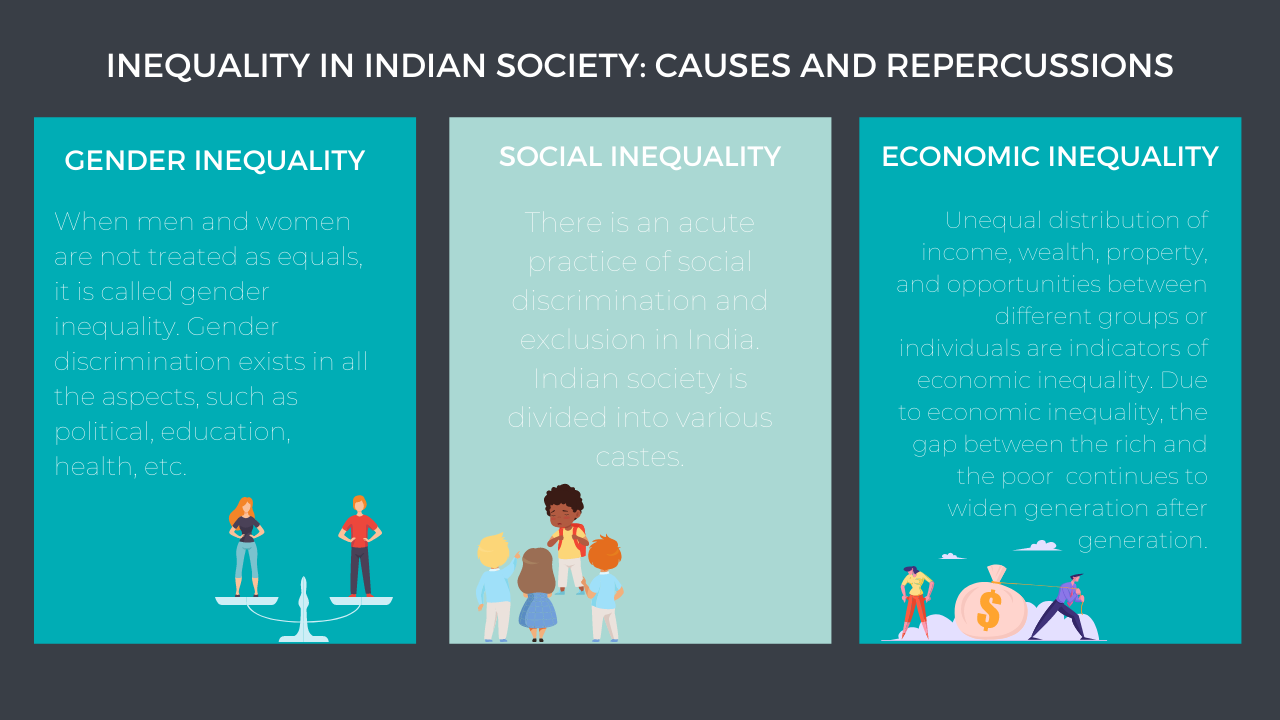Inequality is widely persisting in Indian society. Some sections of the society have greater access to resources like education, health, economic opportunities, etc., as compared to others. The unequal access to these social resources is called – inequality.
The children inherit property, status, money, education, and so on from their parents or grandparents. That is, the children assume the social status of their parents. Hence, Social resources are inherited from generation to generation. A rich person has higher chances of getting higher education in professional fields like medicine, law, engineering, etc., but the poor, due to lesser opportunities to get higher education, are more likely to be confined to occupations such as agricultural labor scavenging or industrial work. People often face discrimination based on their religion, race, caste, language, disability, and gender. Inequality persists over generations.
Classification of inequality
Inequality can be classified as follows-
1.Gender inequality
When men and women are not treated as equals, it is called gender inequality. Gender discrimination exists in all the aspects, such as political, education, health, etc. Female foeticide, infanticide, dowry, domestic violence, and sexual harassment are still prevalent in some sections of society. Women’s participation in higher education, decision making, leadership role, the management role is less than men’s.
Gender disparity is the major hurdle in the overall growth of the country. An increase in women’s participation in the workforce increases the growth and overall wellbeing of the country. Several policies and laws are made by the government to encourage girl children. The “Beti Bachao Beti Padhao scheme” aims to decrease female infanticide and increase the female literacy rate. Similarly, “Sukanya Samridhi yojana “aims at financial security of girl child which can be redeemed at the 18 years of age of the girl for higher education or after the girl attain the age 21 years”. However, more efforts are needed at the grassroots level to sensitize people about gender-related issues, and the government should take the initiative together with the civil society groups to check the proper implementation of policies.
2.Social inequality
There is an acute practice of social discrimination and exclusion in India. Indian society is divided into various castes. During the early Vedic period, people were free to choose their occupation irrespective of their caste, but later things changed, and each caste was associated with an occupation, and persons born into a particular caste had no choice but to choose the occupation belonging to their caste. Each caste is placed in the hierarchy as per their social status. Brahmin (priest) was placed at the top of the hierarch, Kshatriya (warrior) was placed after Brahmins, vaishya (trader) was after Kshatriyas, and at last Shudras ( servant).
In modern times, caste and occupation have become less rigid. People can choose occupations as per their choice nowadays, but the caste system is still present. For example, the upper caste Hindus denying the entry of lower castes into the temples.
The government has taken various steps to improve the situation and condition of the oppressed class by providing them with reservations in education and employment. In addition to this, various laws have been passed to end caste discrimination and untouchability. Article 17 of the Indian constitution makes it a punishable offense. But government actions alone cannot ensure social change; therefore, people at large must be made aware of this, and caste-based discrimination in any form must be shunned.
3.Economic inequality
Unequal distribution of income, wealth, property, and opportunities between different groups or individuals are indicators of economic inequality. Due to economic inequality, the gap between the rich and the poor persists and continues to widen generation after generation.
A report published by OECD in 2011 states that income inequality in India has doubled since the 1990s. As per this report states the wealthiest 10% earn twelve times as much as the poorest 10%.
The effect of income inequality is not only economic, but there are also social and political consequences. High inequality leads to inequality in other social indicators like life expectancy, access to education, nutritional wellbeing, etc.
Land reforms act, employment generation program, social security schemes like Atal pension yojana, PMFBY are some of the measures taken by the government to reduce economic inequality. However, these measures must be complemented by free and good quality education for everyone, providing Health facilities for everyone, especially the poor and marginalized section of the society.
Conclusion:
In a country like India having immense diversity of religion, culture, and values, it is difficult to achieve social equality only by the measures taken by the government. Therefore, to bring this social change, the government’s effort and civil society must go hand in hand. The development of any country is based upon the development of all the people who reside in that country. Hence, equality is necessary for the growth and development of our county, and it brings peace and prosperity to the country.









